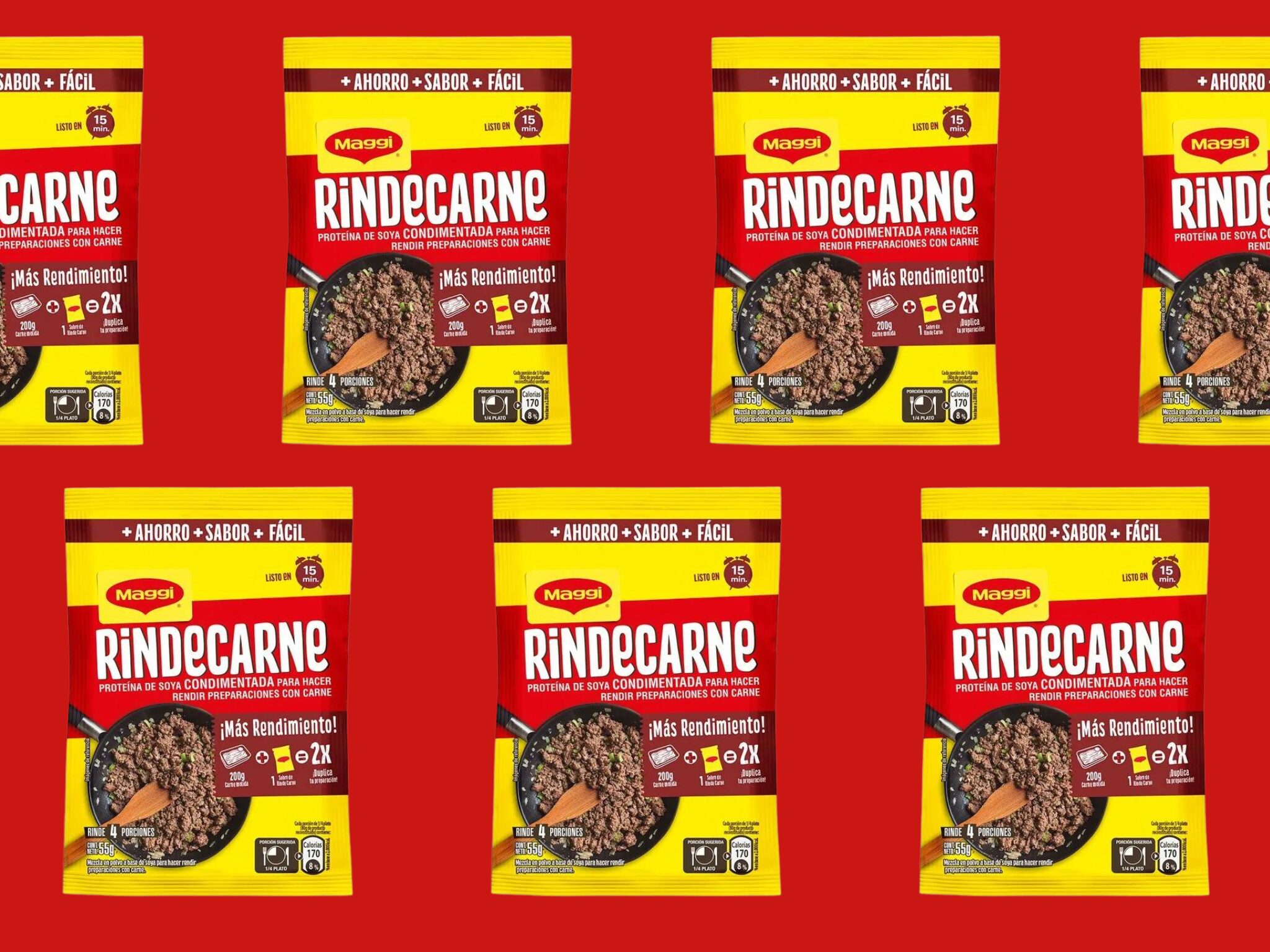4 Mins Read
Nestlé has introduced Maggi Rindecarne, a plant-based meat product meant to be blended with conventional beef, in Chile.
The blended meat category continues to expand, with the world’s largest food company now jumping onto the trend with a plant-based ‘meat extender’.
Launched under its Maggi brand, Nestlé’s new innovation is called Rindecarne, and is essentially seasoned soy protein that comes in minced form to pair with animal-derived meat.
Unlike other blended meat products – which lead with taste credentials – Nestlé’s pitch for this offering is affordability. This is outlined by the fact that this meat extender is currently available in Chile, where the wealth gap has been a major contributor to social inequality for years.
Turning two servings into four

The Maggie Rindecarne has a base of soy protein, soy and wheat flours, and sodium glutamate, with natural flavours and other taste agents like garlic, beetroot, paprika, sugar, pepper, salt, and citric acid. It also has canola oil and natural caramel colouring.
Nestlé says the mix of soy and spices allows for a seamless blend of Rindecarne with minced beef in a range of dishes, doubling the amount of servings “at an affordable price”. This message has headlined its marketing around the product too, with social media posts showing how the blended meat can turn two burger patties and two bowls of spaghetti Bolognese into four each.
But while it is doubling down on the affordability aspect, Nestlé isn’t ignoring the importance of taste and health either, noting how a dish prepared with Maggi Rindecarne “retains its nutritional value without compromising on taste”.
Each serving has 5.2g of protein and only 0.4g of fat (with a minimal amount being saturated). The product is described as “versatile and customisable”, and can be used in a range of dishes like burgers, kebabs, meatballs, pastel de choclo and German meat pies, as well as meat toppers and fillings in lasagne, spaghetti Bolognese, and tacos.
“Our team of experts and chefs developed a tailored solution which brings an equivalent amount of protein in an affordable way to consumers in Latin America,” said Swen Rabe, head of Nestlé’s Product and Technology Center for Food.
As Rindecarne is a dried product, it needs to be reconstituted by soaking in water for 15 minutes, and then being added to ground beef. “Our innovation ensures the familiar taste and texture of mincemeat, is shelf-stable and easy to use,” added Rabe.
This isn’t Nestlé’s first innovation that combines plant and animal proteins. In 2022, it piloted a shelf-stable plant protein blend to complement egg dishes in Latin America. And last year, the company developed a blended milk beverage with dairy and soy milk for Central and West Africa.
Blended meat gathers steam

Nestlé’s decision to introduce blended meat in Chile is a shrewd one. The country’s citizens are reducing their animal intake, mainly due to health and cost concerns.
An Ipsos survey in collaboration with local organisation Fundación Veg (formerly Vegetarianos Hoy) found that 75% of Chileans reduced their consumption of red meat last year. Among those who were cutting back on animal products, 31% cited health reasons and 14% blamed high prices.
The importance of the latter has grown over the last few years, with 14% of respondents who haven’t reduced their animal intake saying they’d consider doing so because of their cost, a six-point increase from 2021.
Another poll by the two organisations found that 73% of Chileans would eat plant-based products if they are equal to or better than their animal counterparts on the nutrition front. Likewise, 72% would buy vegan analogues that have similar or lower prices.
Blended meat is being touted as a game-changer for meat reduction efforts. A sensory analysis published last month showed that most plant-based products don’t satisfy omnivores, but the only product that came within one point in average liking of a conventional burger was the Both Burger by 50/50 Foods, which blends beef with an equal amount of vegetables.
The Both Burger’s success can be underlined by the fact that it is now available in Disneyland. It’s among a host of companies offering blended meat: Phil’s Finest has been doing well ever since it found success on Shark Tank (as Misfit Foods), and Mush Foods’ mycelium-based 50Cut is now part of a blended burger by meat purveyor Pat LaFrieda. Perdue Farms’ Chicken Plus range, which combines chicken with The Better Meat Co‘s mycelium meat, has been one of the most successful stories in the space.
The category’s potential has attracted plant-based companies too. Australia’s Harvest B launched its blended meat lineup in April, while UK meat-free market leader Quorn announced last month that it will offer its mycoprotein to foodservice and hospital caterers across the country for use in blended pork and beef dishes.
“Once upon a time, we were effectively competing with the meat industry – only making products that were alternatives to theirs, and encouraging people to switch,” Quorn CEO Marco Bertacca told Green Queen. “We now find ourselves collaborating to offer less-meat options to consumers who are looking to reduce meat consumption, but not eat vegetarian or vegan meals.”
He added: “This represents the majority of people, and so it is a massive opportunity to decarbonise part of the food system and improve public health.”



